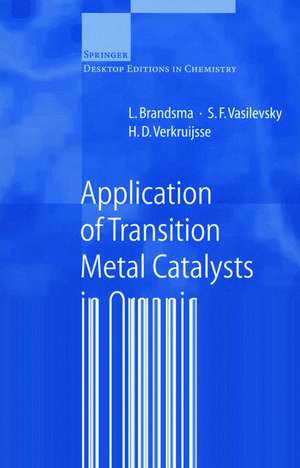Application of Transition Metal Catalysts in Organic Synthesis: Springer Desktop Editions in Chemistry
Autor L. Brandsma, S. F. Vasilevsky, H.D. Verkruijsseen Limba Engleză Paperback – apr 1999
Preț: 643.34 lei
Preț vechi: 756.86 lei
-15% Nou
Puncte Express: 965
Preț estimativ în valută:
123.10€ • 128.54$ • 101.65£
123.10€ • 128.54$ • 101.65£
Carte tipărită la comandă
Livrare economică 15-29 aprilie
Preluare comenzi: 021 569.72.76
Specificații
ISBN-13: 9783540655503
ISBN-10: 3540655506
Pagini: 360
Ilustrații: XIX, 335 p. 16 illus.
Dimensiuni: 155 x 235 x 19 mm
Greutate: 0.5 kg
Ediția:1999
Editura: Springer Berlin, Heidelberg
Colecția Springer
Seria Springer Desktop Editions in Chemistry
Locul publicării:Berlin, Heidelberg, Germany
ISBN-10: 3540655506
Pagini: 360
Ilustrații: XIX, 335 p. 16 illus.
Dimensiuni: 155 x 235 x 19 mm
Greutate: 0.5 kg
Ediția:1999
Editura: Springer Berlin, Heidelberg
Colecția Springer
Seria Springer Desktop Editions in Chemistry
Locul publicării:Berlin, Heidelberg, Germany
Public țintă
ResearchCuprins
1 Catalysts, Ligands and Reagents.- 1.1 Catalysts.- 1.2 Ligands.- 1.3 Organometallic Reagents.- 2 Procedures for the Preparation of Halogen Compounds.- 2.1 sp-Halides.- 2.2 Aryl and Hetaryl Halides.- 2.3 Olefinic, Cycloolefinic and Allenic Halides.- 3 Cross-Coupling Between 1-Alkynes and 1-Bromoalkynes.- 3.1 Introduction.- Table 1.- 3.2 Scope and Limitations.- 3.3 Relative Reactivities of the Acetylene and the Bromoacetylene.- Table 2.- 3.4 Conditions for the Coupling.- 3.5 Choice of the Reaction Partners.- 3.6 Side Reactions.- 3.7 Experimental Part.- 4 Copper-Catalyzed Aminoalkylation of Acetylenes.- 4.1 Introduction, Scope and Mechanism.- 4.2 Experimental Part.- 5 Copper(I)-Halide-Catalyzed Oxidative Coupling of Acetylenes.- 5.1 Introduction.- 5.2 Methods, Scope and Limitations.- 5.3 About the Mechanism.- 5.4 Experimental Part.- 5.5 Summary of Experimental Conditions for Oxidative Couplings.- Table 3.- 6 Copper(I)-Halide-Catalyzed Substitution of sp2-Halogen by Alkoxide.- 6.1 Introduction.- 6.2 Scope and Limitations of the Copper-Catalyzed Nucleophilic Substitution of sp2-Halogen by Alkoxy Groups.- Table 4.- 6.3 Mechanistic Investigations.- 6.4 Reaction Conditions.- 6.5 Differences in the Reactivities of the Various sp2-Halides.- 6.6 Side Reactions.- 6.7 Applications.- 6.8 Experimental Part.- 7 Copper-Catalyzed Carbon-Carbon Bond Formation by 1,1- and 1,3-Substitution Reactions.- 7.1 Introduction.- 7.2 Displacement of Halide, Tosylate and Acetate in Saturated Compounds.- 7.3 Ring Opening of Saturated Epoxides.- 7.4 Reactions with Allylic Substrates.- 7.5 Reactions with Propargylic and Allenic Substrates.- 7.6 About the Mechanism of Copper Catalyzed Substitutions.- 7.7 Experimental Section.- Table 5.- Table 6.- 8 Nickel Catalyzed Iodo-Dechlorination and Iodo-Debromination of sp2-Halides.- 8.1 Introduction.- 8.2 Scope and Limitations.- 8.3 Mechanistic Investigations.- 8.4 Side Reactions.- 8.5 Experimental Procedures.- 8.6 Conclusions from our Investigations.- 9 Nickel- and Palladium-Catalyzed Cyanation of sp2-Halides and sp2-Triflates.- 9.1 Introduction.- 9.2 Scope and Limitations.- Table 7.- 9.3 Mechanism of the Nickel Catalyzed Cyanation.- 9.4 Methods of Performing Nickel Catalyzed Cyanations.- 9.5 Relative Reactivities of sp2-Halides.- 9.6 Side Reactions.- 9.7 Catalysis by Palladium Compounds.- 9.8 Experimental Part.- 10 Couplings of Acetylenes with sp2-Halides.- 10.1 Introduction.- 10.2 Mechanistic Considerations.- 10.3 Scope and Limitations.- Table 8.- 10.4 Relative Rates of Coupling.- 10.5 Regiochemistry and Stereochemistry.- 10.6 Synthetic Applications of the Cross-Coupling Reactions with Acetylenes.- 10.7 Practical Aspects of the Coupling Reactions.- 10.8 Experimental Section.- 11 Nickel- and Palladium-Catalyzed Cross-Coupling Reactions with Organometallic Intermediates.- 11.1 Introduction.- 11.2 Possibilities of Connecting Organic Groups by Transition Metal Catalysis.- 11.3 Catalysts and Ligands.- 11.4 Leaving Groups.- 11.5 Couplings with Organolithium Compounds.- 11.6 Couplings with Organomagnesium and Organozinc Halides.- 11.7 Cross Couplings with Organoaluminum, Organoboron and Organotin Compounds.- 11.8 Regiochemical and Stereochemical Aspects.- 11.9 Mechanism and Side Reactions.- 11.10 Practical Aspects of Transition-Metal-Catalyzed Couplings.- 11.11 Experimental Section.- Tables 9-20.- Index of Reaction Types.- Index of Experimental Procedures.- Complementary Subject Index.
Textul de pe ultima copertă
Homogeneous catalysis is an important strategy for the synthesis of high-valued chemicals. L. Brandsma has carefully selected and checked the experimental procedures illustrating the catalytic use of copper, nickel, and palladium compounds in organic synthesis. All procedures are on a preparative scale, make economic use of solvents and catalysts, avoid toxic substances and have high yields.
Caracteristici
Very affordable price * For the personal libraries of graduates and scientists working at the cutting edge of academic, industrial and pharmaceutical research.

























